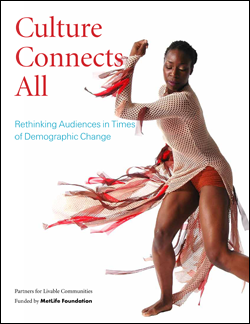Culture Connects All
Rethinking Audiences in Times of Demographic Change
116 pages, May 2012. Partners for Livable Communities, 1429 21st Street NW, Washington, D.C. 20036, (202) 887-5990 www.livable.org.
Download:
![]() Culture Connects All (1Mb)
Culture Connects All (1Mb)
Culture Connects All, a benchmark report published by Partners for Livable Communities and funded by MetLife Foundation, offers new audience-building opportunities for arts and cultural organizations to engage two of America’s fastest growing populations: older adults and immigrant populations.
The 2010 census confirms what many have observed over the past decade—the population is growing older, and in many areas more diverse. And this change is happening across the face of the nation. Two rapidly expanding population groups present a timely opportunity for communities and their arts and cultural institutions to rethink and retool their outreach.
Arts and cultural organizations traditionally have two main roles: the production of arts or cultural activities, and the presentation of them to an audience. Both of these roles fundamentally involve people, as producers or as spectators; it is people who give cultural organizations their means and purpose. Given this importance, when demographics change, cultural organizations must pay attention; and demographics are indeed changing. Two of the fastest growing population groups present a timely opportunity for engagement but are at risk for being ignored by many cultural organizations that could benefit from their participation.
Which are these two rapidly expanding populations? They are the rising tide of immigrants and older adults. Whether looking at the ever-increasing waves of immigration or the incoming wave of adults over the age of 65, it is clear that America’s demographic makeup is increasingly diverse and proportionally older than in the past. Arts and cultural organizations may not be recognizing the populations that need them most, and with them the host of opportunities to increase their reach and resources in the community.
To understand whether and how many arts and cultural organizations are already adapting to these changes, Partners for Livable Communities researched and interviewed cultural organizations in six cities (Atlanta, Chicago, Dallas, New York City, Phoenix and Tampa); Partners began this project building on years of experience working with cultural organizations on social and economic development.
This report briefly describes the state of the arts and culture sector, followed by in-depth examinations of the two populations: immigrants (those who are foreign-born) and older adults (those aged 65 and over). Within these discussions, the report describes some of the most salient aspects of these groups for cultural organizations and how they can and already do engage with the cultural sector.
The findings are clear: organizations must look inside their programming and operations, and outside their ‘four walls,’ to create meaningful partnerships, participate in and listen to the community, and generally embody the spirit of being a ‘good neighbor.’ The key to addressing these findings is to understand the value of mutually beneficial relationships. These organizations have built a new and broader base of patrons, but they have not accomplished this through marketing alone. Instead, they have made a fundamental commitment to supporting their communities, often in fresh and novel ways.
The second part to this report distills from the discussions with leaders in arts and cultural organizations in the six cities and presents their valuable insights into building both audiences and community. These organizations were chosen because they all found methods for creating arts and cultural experiences that satisfy the interests and any specialized needs of their immigrant and older adult audiences.

